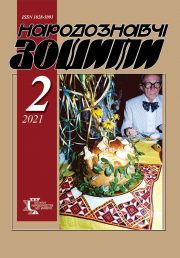The Ethnology Notebooks. 2021. # 1 (157), P. 119—130
УДК [738.84.03.011.26:666.3](477.83-25)”19″
DOI https://doi.org/10.15407/nz2021.01.119
Romana MOTYL
- ORCID ID: http://orcid.org/0000-0001-6936-0328
- Candidate of Arts (Ph. D), Associate Professor,
- Department of Design and Architecture Fundamentals
- Lviv Polytechnic National University
- 12 Bandery St., 79013, Lviv, Ukraine;
- Senior Researcher at Folk Art Department,
- Ethnology Institute of NAS of Ukraine,
- 15, Svobody ave., 79000, Lviv, Ukraine
- e-mail: romana_motyl@ukr.net
Introduction. Today, as never before, there is an urgent need for a comprehensive study of the activities of the Lviv Experimental Ceramic and Sculptural Factory (LECSF) as an extraordinary phenomenon of the second half of 20-th century, because so far all publications on the functioning and role of the factory in the system of creative development of ceramics were covered insufficiently and rather fragmentarily.
The aim of the article is to study the Lviv Experimental Ceramics and Sculpture Factory as a factor in the creative development of the Lviv school of ceramics in the second half of the 20-th century.
Results. An important fact in the development of the Lviv school of ceramics in the middle of the 20 — early 21 century іs consider the presence of a powerful material and technical base — in 1946 in Lviv, opened Lviv Ceramic Sculpture Factory.
Until 1963, LEKSF ceramic products were cast from gypsum molds in faience mass. After the modernization of the production technology, three large ceramic kilns were put into operation, and this made it possible to make majolica products from stone mass and fireclay.
In the 1960’s and 1970’s, active creative searches of Lviv ceramists gave grounds to state the fact of formation of a local school of professional ceramics, which is confirmed by the appearance of a whole cohort of original artists, bright personalities. Since the end of the 1980s, the system of the Artistic Fund of the Union of Artists has been declining. The situation became even more complicated in the early 1990s, when domestic ceramics companies were gripped by economic cataclysms.
Conclusion. Lviv ceramists carried out their plans in almost all known ceramic materials, designed both miniature and monumental works, made unique original things and samples of serial production. They relying on folk traditions and bold authorial experiments, formed the Lviv School of Ceramics, recognizable and competitive both in Ukraine and abroad.
Keywords: Lviv Experimental Ceramic and Sculptural Factory, production, technology, ceramics, artists-ceramists, folk traditions, experiments.
REFERENСES
- Holubets’, O.M. (2001). Between freedom and totalitarianism. The artistic environment of Lviv in the second half of the 20 century. Lviv: Akademichnyj ekspres [in Ukrainian].
- Novyts’ka, O.R. (2003). Ukrainian folk art of the 1920s and 1980s: interpretation, evaluation, and refutation: avtoref. dys. …na zdobuttia kand. mystetstv. 17.00.06. «Decorative and Аpplied Аrts». L’viv [in Ukrainian].
- Holubets’, O.M. (1991). Lviv ceramics. Kyiv: Naukova dumka [in Ukrainian].
- Sheremeta, Ya., & Poshyvajlо, O. (Ed.). (2019). Memories about teacher. Ukrainian Ceramology: National Scientific Yearbook. For the year 2008: Personalities of Ukrainian ceramology (Vol. 3, book IV). Opishne: Ukrains’ke narodoznavstvo [in Ukrainian].
- Lashchuk, Yu. (Ed). (1970). Lviv ceramics: album. Lviv: Kameniar [in Ukrainian].
- Kuma, Kh. (1976). About national schools. Decorative Art of the USSR, 3, 40—43 [in Russian].
- Kara-Vasyl’ieva, T.V., & Chehusova, Z.A. (2005). Decorative Art of Ukraine of the 20 century. In search of great style. Kyiv: Lybid’ [in Ukrainian].
- Retrieved from: https://zik.ua/ru/news/2007/10/31/lvovskaya._keramykoskulpturnaya_fabryka_rasprodaet_svoy_sklad_stekla_117464 [in Russian].







